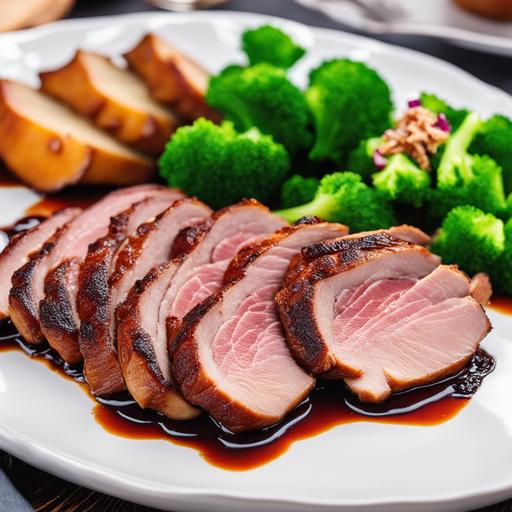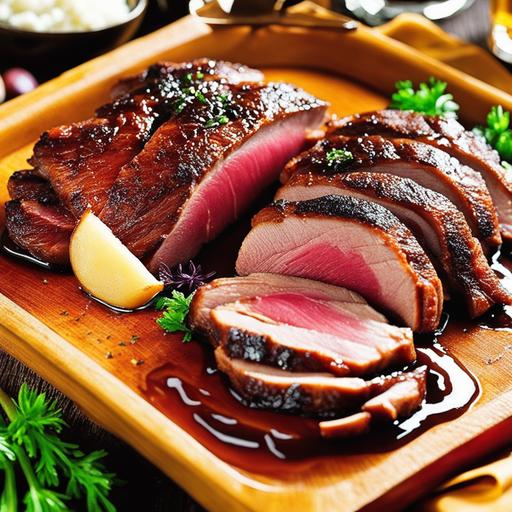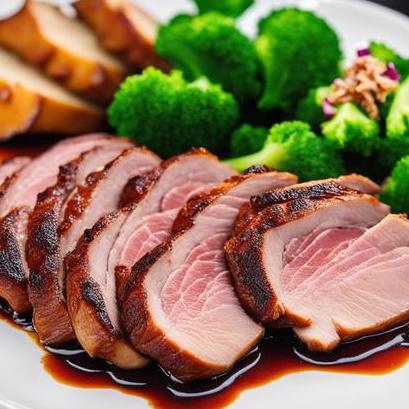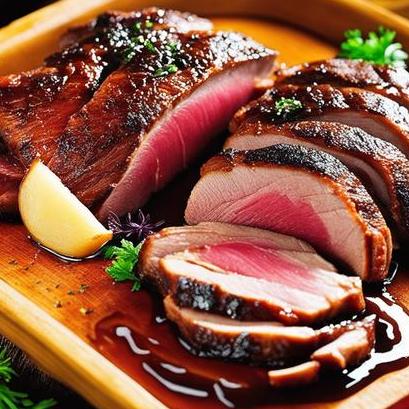
Duck Breast Oven Recipe: The Ultimate Guide
Duck breast is a delicacy enjoyed by many for its rich flavor and tender texture. While it may seem intimidating to cook at home, with the right techniques and recipe, you can easily create a restaurant-quality dish in your own kitchen. In this comprehensive guide, we will delve into the food science behind cooking duck breast in an oven, discuss how to choose the best ingredients, provide detailed instructions on preparing the ingredients, and outline the optimal oven cooking temperature and timing. Finally, we will present a step-by-step duck breast oven recipe to help you achieve perfect results every time.
Food Science Of Cooking Duck Breast In An Oven
Understanding the science behind cooking duck breast is essential for achieving the perfect balance of flavor, texture, and juiciness. Duck breast is a rich and fatty cut of meat, which requires careful handling to ensure it is cooked to perfection. When exposed to heat, the fat in the duck breast renders, resulting in a crispy skin and tender meat. However, overcooking can lead to dry and tough meat, while undercooking can result in an unpleasant texture and potential food safety risks.
The key to cooking duck breast in an oven lies in controlling the temperature and timing. By starting with a hot oven to crisp the skin and then reducing the temperature to gently cook the meat to the desired doneness, you can achieve succulent and flavorful duck breast every time. Additionally, allowing the duck breast to rest after cooking is crucial as it allows the juices to redistribute, ensuring a moist and tender final product.
Choosing Ingredients
Selecting high-quality ingredients is essential for creating a delicious duck breast dish. When choosing duck breast, look for plump breasts with a thick layer of fat and a deep red color. Fresh duck breast should have a clean, slightly sweet aroma and feel firm to the touch. Avoid duck breast with a strong, gamey odor or any signs of discoloration or bruising.
In addition to the duck breast itself, consider the accompanying ingredients for seasoning and flavoring. Common herbs and spices used to enhance the flavor of duck breast include thyme, rosemary, garlic, and citrus zest. You may also want to have ingredients for a sauce or glaze, such as honey, balsamic vinegar, or fruit preserves, to complement the rich flavor of the duck.
Preparing Ingredients

Before cooking duck breast in the oven, proper preparation is key to ensuring optimal results. Start by patting the duck breast dry with paper towels to remove any excess moisture, which will help achieve a crispy skin when cooked. Score the skin of the duck breast with a sharp knife in a crosshatch pattern, being careful not to cut into the meat.
Next, season the duck breast generously with salt and any desired herbs or spices, making sure to rub the seasoning into the skin and flesh. Allow the seasoned duck breast to rest at room temperature for about 30 minutes before cooking to ensure even cooking and better flavor absorption.
While the duck breast is resting, prepare any accompanying ingredients or side dishes. This could include making a sauce or glaze, roasting vegetables, or preparing a salad to serve alongside the duck breast.
Optimal Oven Cooking Temperature & Timing
Cooking duck breast in the oven requires careful attention to temperature and timing to achieve the perfect balance of crispy skin and tender meat. Preheat your oven to 425°F (220°C) to ensure a hot oven for crisping the skin. Once the oven is preheated, place the seasoned duck breast skin-side down in a cold, oven-safe skillet or roasting pan.
Roast the duck breast in the preheated oven for 6-8 minutes, or until the skin is golden brown and crispy. Carefully remove the pan from the oven and flip the duck breast skin-side up using tongs or a spatula. Reduce the oven temperature to 350°F (175°C) and return the duck breast to the oven to continue cooking.
Continue roasting the duck breast for an additional 8-10 minutes, or until the internal temperature reaches 135°F (57°C) for medium-rare or 145°F (63°C) for medium. Use a meat thermometer inserted into the thickest part of the duck breast to accurately gauge the internal temperature. Keep in mind that the duck breast will continue to cook as it rests, so it’s essential to remove it from the oven slightly before reaching the desired doneness.
Once the duck breast reaches the desired temperature, remove it from the oven and transfer it to a cutting board. Tent the duck breast loosely with aluminum foil and allow it to rest for at least 5 minutes before slicing. This resting period allows the juices to redistribute, resulting in a juicy and tender final product.
Duck Breast Oven Recipe
Ingredients
- 2 duck breasts
- Salt
- Pepper
- Fresh thyme
- Fresh rosemary
- 2 cloves garlic, minced
- Olive oil
Instructions
- Preheat the oven to 425°F (220°C).
- Score the skin of the duck breasts in a crosshatch pattern and season generously with salt, pepper, minced garlic, and chopped herbs.
- Allow the seasoned duck breasts to rest at room temperature for 30 minutes.
- Heat a skillet or roasting pan over medium-high heat and add a drizzle of olive oil.
- Place the seasoned duck breasts skin-side down in the hot skillet and sear for 2-3 minutes, or until the skin is golden brown and crispy.
- Carefully flip the duck breasts skin-side up using tongs or a spatula.
- Transfer the skillet to the preheated oven and roast for 6-8 minutes.
- Reduce the oven temperature to 350°F (175°C) and continue roasting for 8-10 minutes, or until the internal temperature reaches 135°F (57°C) for medium-rare or 145°F (63°C) for medium.
- Remove the duck breasts from the oven and transfer to a cutting board.
- Tent the duck breasts loosely with aluminum foil and allow them to rest for at least 5 minutes before slicing.
- Serve the sliced duck breasts with your favorite sides and enjoy!
Cooking duck breast in the oven is a rewarding culinary experience that yields tender, flavorful results when done correctly. By understanding the food science behind cooking duck breast, selecting high-quality ingredients, properly preparing the ingredients, and controlling the oven temperature and timing, you can create a restaurant-quality dish in the comfort of your own home. With the detailed duck breast oven recipe provided, you can confidently cook duck breast to perfection and impress your family and friends with your culinary skills. So, roll up your sleeves, preheat your oven, and get ready to enjoy a delicious and memorable meal!
Doneness Checks

Before diving into the cooking process, it’s essential to understand the basics of duck breast preparation. Duck breast, known for its robust flavor and succulent meat, requires careful cooking to achieve the perfect balance of tenderness and crispiness. When cooked correctly, duck breast can rival the finest cuts of steak in both taste and texture.
Determining the doneness of duck breast is crucial to ensure a delectable dining experience. Unlike chicken or beef, duck breast is best served medium-rare to medium to preserve its tenderness and flavor. Here are some methods for checking the doneness of duck breast:
1. Internal Temperature
Using a meat thermometer is the most accurate way to gauge the doneness of duck breast. Insert the thermometer into the thickest part of the breast, being careful not to touch the bone. For medium-rare duck breast, aim for an internal temperature of 130-135°F (54-57°C). For medium doneness, target 140-145°F (60-63°C).
2. Finger Test
If you don’t have a meat thermometer on hand, you can use the finger test to assess the doneness of duck breast. Gently press the center of the breast with your fingers. For medium-rare, the meat should feel firm yet yielding, similar to the texture of the fleshy part of your palm below the thumb. For medium, the meat will be slightly firmer.
3. Visual Inspection
Visual cues can also indicate the doneness of duck breast. A medium-rare duck breast will have a rosy-pink center with some juices pooling on the surface. In comparison, a medium duck breast will have a slightly lighter pink center with fewer juices.
Undercooking
Undercooking duck breast can result in tough, chewy meat that lacks flavor. To avoid undercooking, follow these tips:
- Use a meat thermometer to ensure the internal temperature reaches the desired level.
- Allow the duck breast to rest after cooking to allow residual heat to continue cooking the meat slightly.
- If in doubt, it’s better to slightly overcook the duck breast than to undercook it.
Overcooking
Overcooking duck breast can lead to dry, rubbery meat that is unpleasant to eat. To prevent overcooking, consider the following:
- Monitor the internal temperature closely and remove the duck breast from the oven as soon as it reaches the desired doneness.
- Avoid cooking duck breast at high temperatures for an extended period, as this can cause the meat to become tough.
- Let the duck breast rest before slicing to allow the juices to redistribute and prevent them from drying out.
Troubleshooting

Even with careful preparation, issues may arise during the cooking process. Here are some common problems encountered when cooking duck breast in the oven and how to address them:
1. Tough Meat
If the duck breast turns out tough, it may have been overcooked. To salvage the situation, consider slicing the meat thinly and serving it with a flavorful sauce or gravy to add moisture and enhance the taste.
2. Burnt Skin
Burnt skin can detract from the overall enjoyment of duck breast. To prevent this, ensure that the skin is thoroughly dried before cooking and monitor the oven closely to prevent excessive browning. If the skin does become burnt, carefully trim off the charred portions before serving.
3. Uneven Cooking
Uneven cooking can occur if the duck breast is not of uniform thickness or if the oven temperature is not consistent. To address this issue, consider pounding the duck breast to an even thickness before cooking or rotating the breast halfway through the cooking process to ensure even browning.
Recipe Variations
Now that you have mastered the basics of cooking duck breast in the oven, let’s explore some delicious recipe variations to elevate your culinary repertoire:
1. Orange Glazed Duck Breast
- Marinate duck breast in a mixture of orange juice, soy sauce, honey, garlic, and ginger.
- Roast in the oven until cooked to medium-rare, basting with the marinade halfway through.
- Serve with a side of roasted vegetables and drizzle with extra orange glaze before serving.
2. Balsamic-Honey Duck Breast
- Season duck breast with salt, pepper, and a drizzle of balsamic vinegar and honey.
- Roast in the oven until medium-rare, then let rest before slicing thinly.
- Serve over a bed of mixed greens with a balsamic reduction for added flavor.
3. Five-Spice Duck Breast
- Rub duck breast with a mixture of five-spice powder, garlic powder, salt, and pepper.
- Sear in a hot skillet to render the fat and crisp the skin, then finish in the oven until medium-rare.
- Serve sliced with steamed rice and stir-fried vegetables for a flavorful Asian-inspired meal.
Cooking duck breast in the oven is a rewarding culinary endeavor that yields tender, flavorful meat with crispy skin. By mastering the doneness checks, troubleshooting common issues, and exploring recipe variations, you can create restaurant-quality duck dishes in the comfort of your own kitchen. Whether you prefer classic preparations or experimental flavor combinations, there’s a duck breast recipe to suit every palate. So, roll up your sleeves, preheat the oven, and embark on a culinary journey that celebrates the delicious versatility of duck breast.
Flavour Enhancement Tips
Duck breast is a delicacy cherished by many for its rich flavor and succulent texture. While commonly associated with gourmet dining, preparing duck breast at home can be a rewarding culinary experience.
1. Marinade Magic
Marinating duck breast before cooking can infuse it with additional flavors and tenderize the meat. Common marinade ingredients include soy sauce, honey, orange zest, garlic, and herbs like thyme or rosemary. Allow the duck breast to marinate for at least 30 minutes or overnight in the refrigerator for maximum flavor penetration.
2. Spice Rubs
Create a custom spice rub using a combination of your favorite herbs and spices. Paprika, cumin, coriander, and black pepper can add depth and complexity to the flavor profile of the duck breast. Ensure that the spices are evenly distributed on the surface of the meat for consistent seasoning.
3. Citrus Zest
The zest of citrus fruits such as orange, lemon, or lime can brighten the flavor of duck breast and complement its richness. Sprinkle freshly grated citrus zest over the duck breast before cooking or incorporate it into marinades for a burst of freshness.
4. Basting With Aromatic Oils
During the cooking process, baste the duck breast with aromatic oils infused with garlic, herbs, or spices. This not only adds moisture to the meat but also imparts additional flavor and aroma. Use a brush or spoon to evenly coat the surface of the duck breast with the infused oil.
Texture Enhancement Tips

1. Score The Skin
Before cooking, score the skin of the duck breast with a sharp knife in a crosshatch pattern. This helps render the fat more effectively during cooking, resulting in a crispy, golden-brown skin. Be careful not to cut too deeply into the meat to avoid overexposing it to direct heat.
2. Pat Dry
Ensure that the surface of the duck breast is thoroughly pat dry with paper towels before cooking. Excess moisture on the skin can inhibit crisping and caramelization, leading to a less desirable texture. Removing moisture also allows for better seasoning adherence and promotes even browning.
3. Resting Period
After cooking, allow the duck breast to rest for a few minutes before slicing and serving. This resting period allows the juices to redistribute within the meat, ensuring a moist and tender texture. Cover the duck breast loosely with foil to retain heat while resting.
Cooking At Different Temperatures
1. High Temperature Roasting
Preheat the oven to 425°F (220°C) for high-temperature roasting. Place the seasoned duck breast skin-side down in a preheated skillet or oven-safe pan and sear for 2-3 minutes until the skin is golden and crisp. Flip the breast and transfer the pan to the oven to roast for an additional 8-10 minutes for medium-rare or until the desired level of doneness is reached.
2. Low Temperature Roasting
For a slower, more controlled cooking method, preheat the oven to 300°F (150°C) for low-temperature roasting. Place the seasoned duck breast skin-side down in an oven-safe pan and roast for 15-20 minutes, depending on thickness, until the internal temperature reaches 130°F (54°C) for medium-rare. Allow for additional cooking time if a higher level of doneness is preferred.
Cooking Tips
1. Use A Meat Thermometer
To ensure optimal doneness, use a meat thermometer to gauge the internal temperature of the duck breast. Insert the thermometer probe into the thickest part of the meat, avoiding contact with bone or fat. For medium-rare duck breast, aim for an internal temperature of 130°F (54°C), while medium should reach 140°F (60°C).
2. Keep An Eye On The Fat
Duck breast contains a layer of fat beneath the skin that renders during cooking. Monitor the rendering process to prevent excessive smoking or burning, especially when cooking at high temperatures. You can pour off excess rendered fat from the pan periodically to prevent flare-ups and maintain a clean oven environment.
3. Rest Before Slicing
Allow the cooked duck breast to rest for 5-10 minutes before slicing to retain moisture and ensure juiciness. Slicing too soon can cause the juices to escape, resulting in dry meat. Use a sharp knife to slice the duck breast against the grain into thin, even slices for optimal tenderness.
Serving Suggestions
1. Accompaniments
Serve the sliced duck breast alongside an array of complementary accompaniments such as roasted vegetables, mashed potatoes, or a crisp salad. The richness of the duck pairs well with the earthy sweetness of roasted root vegetables or the freshness of citrus-dressed greens.
2. Sauces And Glazes
Elevate the flavor profile of the duck breast with homemade sauces or glazes. A classic orange or cherry sauce adds a tangy sweetness that enhances the natural richness of the meat. Alternatively, drizzle reduced balsamic vinegar or a honey-mustard glaze over the sliced duck breast for a gourmet touch.
3. Wine Pairing
Pair the duck breast with a medium to full-bodied red wine such as Pinot Noir, Merlot, or Syrah. The fruity undertones and subtle tannins of these wines complement the robust flavor of the duck while balancing its richness. Alternatively, opt for a crisp, acidic white wine like Chardonnay or Sauvignon Blanc to contrast the richness of the duck with refreshing acidity.
Conclusion
Cooking duck breast in the oven allows for precise control over the cooking process, resulting in tender, flavorful meat with crispy skin. By incorporating flavor enhancement techniques, monitoring cooking temperatures, and mastering cooking tips, you can create restaurant-quality duck breast dishes in the comfort of your own kitchen. Experiment with different seasonings, accompaniments, and wine pairings to customize your culinary creations and impress your guests with an unforgettable dining experience. With this comprehensive guide, you’re well-equipped to embark on your journey to mastering the art of cooking duck breast in the oven. Bon appétit!
FAQS
What Kind Of Duck Breast Is Best For This Oven Recipe?
The best kind of duck breast for this recipe is the lean and meaty Moulard duck breast. It has a deep and rich flavor and is usually sold in specialty stores or online.
Should I Sear The Duck Breast Before Putting It In The Oven?
It is recommended to sear the duck breast on both sides before putting it in the oven. This will ensure a crispy and golden brown skin.
How Long Should I Cook The Duck Breast For In The Oven?
Cook the duck breast in the oven for about 8-10 minutes per half-inch of thickness. For example, if your duck breast is one inch thick, you should cook it for about 16-20 minutes.
How Can I Tell If The Duck Breast Is Cooked Through?
To check if the duck breast is cooked through, insert a meat thermometer into the thickest part of the breast. It should read 125-130°F for medium-rare and 135-140°F for medium.
Can I Make A Sauce To Go With The Duck Breast?
Yes, you can make a delicious sauce to go with the duck breast. A classic sauce is a red wine reduction with shallots and herbs or a fruity sauce made with berries and vinegar. Simply mix the ingredients in a saucepan and let it simmer until it thickens. Serve the sauce over the sliced duck breast.


